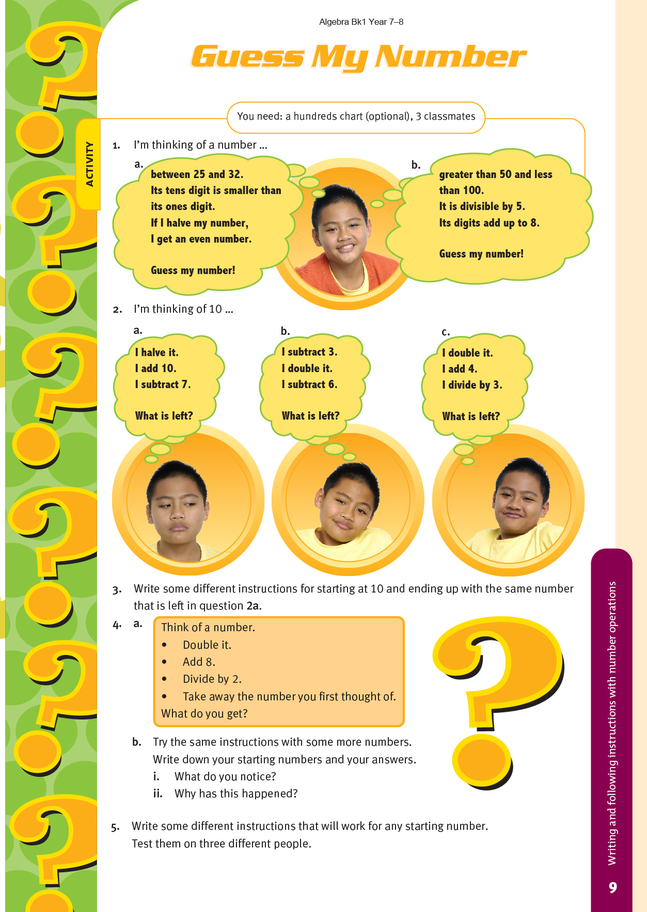This is a level 3 algebra strand link activity from the Figure It Out series.
A PDF of the student activity is included.
Click on the image to enlarge it. Click again to close. Download PDF (229 KB)
explore equations puzzles
write an equation puzzle
hundreds chart (optional)
FIO, Link, Algebra, Book One, Guess my Number, page 9
3 classmates
In this activity, the students follow sets of instructions as they work with numbers and arithmetic operations. They use their number knowledge to reason the outcome of sets of instructions on particular numbers and then to generalise the effect of the instructions on any number.
In question 1a, the students need to examine the numbers between 25 and 32 and eliminate those that do not satisfy the given conditions. They first eliminate 30 and 31 because their tens digits are greater than their ones digits. Of the remaining numbers, only 28 gives an even number when it is halved. The other numbers, 26, 27, and 29, give either an odd number or a fraction when they are halved. So the number “I am thinking of” is 28. In question 1b, the students examine multiples of 5 from 55 to 95. Multiples of 5 end in either 5 or 0. Because we are told that the number is even, we can ignore all the multiples that end in 5. This leaves 60, 70, 80, and 90. Only 80 has digits that add up to 8.
In question 2, the students will find that when they carry out the three different sets of instructions beginning with 10, the result (8) is the same in each case. The students might like to try writing the equations that capture these operations. They are:
i. 10 ÷ 2 + 10 – 7 = 8
ii. (10 – 3) x 2 – 6 = 8
iii. (10 x 2 + 4) ÷ 3 = 8
(The correct positioning of brackets will be critical in the last two equations.)
Encourage the students to explore starting numbers other than 10. They may be surprised that the results are all different for such numbers.
In question 3, encourage the students to use at least one multiplication or division in their operations to avoid instructions of the form “Add 2 then subtract 4”, and so on.
In question 4, the students will find they always get 4 as an answer no matter what starting number they use. This surprises many and consequently encourages further exploration as to why this happens. In this case, the effect of the set of instructions on any starting number is the same as doing nothing. This is explained in the Answers.
In question 5, the students will find it challenging to write sets of instructions that produce the same effect as in question 4. They will need to experiment and should talk with each other about how they have devised the instructions to ensure that the result is always the same as the starting number.
Answers to activity
1. a. 28
b. 80
2. a. 8
b. 8
c. 8
3. Answers will vary.
4. a. 4
b. i. The answer is always 4.
ii. When twice a number plus 8 is divided by 2, you always get the original number plus 4. When the original number is subtracted from this, the answer is always 4.
5. Answers will vary.
